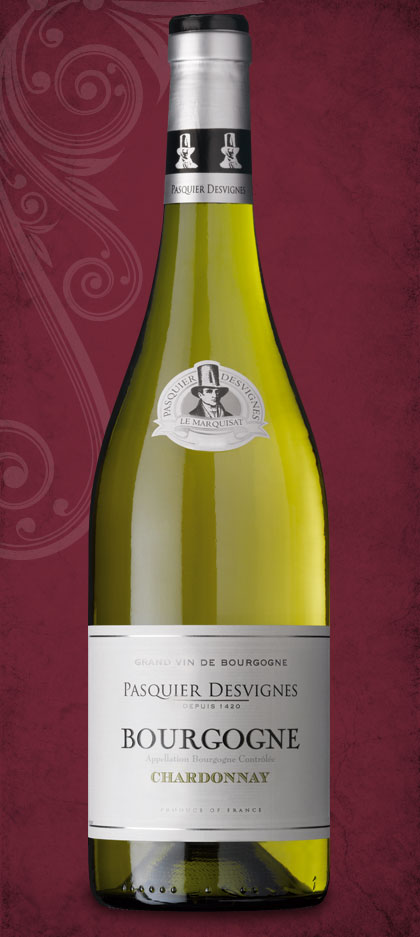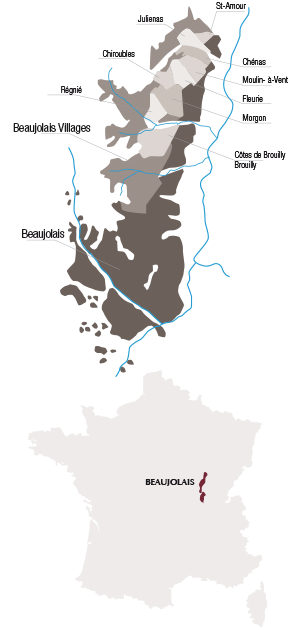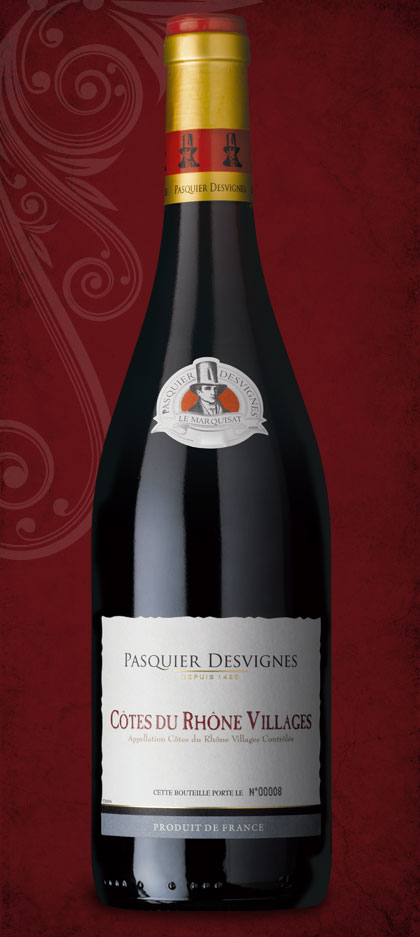The Story of the man with the Hat
HISTORY
The Pasquier Desvignes house, the story of the man with the hat

The name "Desvignes", in earlier times written "des Vignes", meaning "from the vine", is a clear clue to the type of farming this rural family has always specialised. Rarely has a family shown more attachment to its province and the heritage of its ancestors. Nicolas Desvignes, was a counsellor to the king, salt tax inspector in the Macon region, and deputy mayor.
The Pasquier Desvignes family has been the owner of the Domaine du Marquisat since 1420.
In 1823, César Desvignes, the "Man with the hat", took an oath with his brothers, promising that the name Desvignes would remain forever attached to the Domaine du Marquisat.
In memory of this pact, the house of Pasquier Desvignes, through the selection, vinification and storage of its wines, has perpetuated the ancestral know-how on which its reputation is built.
Pasquier Desvignes is more than a tradition of wine-growing spanning 5 centuries, it is a great House. Over the years, it has successfully expanded its range of wines with best-knowed appellations such as the Rhône and the Burgundy.

Range
House of Burgundy with over 5 centuries of history and an premium positioning.
Burgundy,
tradition of the Heart.
Burgundy was the first wine-growing region where the Pasquier Desvignes family was present. The wine-growing area of Burgundy stretches from the Yonne department, in the north, to the Saône-et-Loire in the south. The famous Burgundy grape variety Pinot Noir,
has built the fame and fortune of the greatest Burgundy reds.
Chardonnay is used to produce the Burgundy whites. These wines
are harvested all over the region on strictly demarcated plots called "climates", due to specific geological and climatic conditions.
These "climates" give each Burgundy appellation a unique and remarkable organoleptic personality.


-
Bourgogne Chardonnay
Appellation d'origine protégée
- Grape: 100% Chardonnay.
- Location: the heart of Burgundy.
- Soil: limestone & clay-limestone.
- Colour: slighty golden yellow with emerald reflections.
- Bouquet: a complex Bouquet of flower and fruit with notes of dry fruit with a fine vanilla tang.
- Body: generous and full with a touch of mineral and a bright and lingering fresh finish.
- Wine & Dine: ideal for fish, frog legs and goat's cheese.
- Serving Temperature: 10-12°C.
- Cellar life: 2 to 3 years.

-
Bourgogne Pinot Noir
Appellation d'origine protégée
- Grape: 100% Pinot Noir.
- Location: the heart of Burgundy.
- Soil: marl & soft limestone.
- Colour: beautiful cherry red with slight blick-red shades.
- Bouquet: an intense aroma evoking blackcurrant blended with fine spices.
- Body: generous and mellow, combining boldness and vivacity for a lingering aromatic finish.
- Wine & Dine: Ideal for roast poultry and beef.
- Serving Temperature: 14-16°C.
- Cellar life: 3 to 5 years.
Chablis,
The grand Burgundy vintage.
The vineyards of Chablis stretch over the hills along the edges
of the Serein valley. This is rolling countryside with tree-covered hill-tops.
The soil is composed of stony clay and limestone. In this part
of the country, summers are hot and winters long and hard. This land
is the preferred home of Chardonnay, the only grape variety authorised
in the production of all the white wines from Chablis vineyards.
Chablis wines are one of the finest expressions of the great white wines
from Burgundy: great structure, finesse and heady aromas.

-
Chablis
Appellation d'origine protégée
- Grape: 100% Chardonnay.
- Location: Northern Burgundy.
- Soil: Story.
- Colour: straw yellow with green reflections.
- Bouquet: floral aromas with a hint of fruit, lightly smoked, great intensity.
- Body: well-balanced and smooth, slightly buttery with a bright, fresh finish.
- Wine & Dine: recipes with scallops, fish in sauce.
- Serving Temperature: 10-12°C.
- Cellar life: 2 to 3 years.

Beaujolais,
Greater Burgundy.
Further to the introduction of wine origin appellations in 1936,
the region of Beaujolais was attached to Burgundy to form what
is now called "Greater Burgundy".
Beaujolais can be split into 2 majors areas: the North is composed
of granite and shale soils, suited to the development of great vintages.
The South is composed of clay-limestone soils ideal for the new wines, also called "primeurs".
This is a land in its own right rich in history and customs. Gamay,
a typical white juice grape variety, is the secret of the Beaujolais wine. This North/South interchange was the thinking behind the decision
of the Desvignes family to extend its range and include Beaujolais wines.


-
Beaujolais
Appellation d'origine protégée
- Grape: 100% Gamay.
- Location: the heart of Beaujolais, close to Villefranche-sur-Saône.
- Soil: clay-limestone & silt.
- Colour: ruby with deep purple shades.
- Bouquet: fine and fruity with hints of small red fruits.
- Body: smooth and light, lively, very pleasant with a lingering fruity finish.
- Wine & Dine: delicatessen, roast pork, poultry.
- Serving Temperature: 12-14°C.
- Cellar life: 2 to 3 years.

-
Beaujolais Villages
Appellation d'origine protégée
- Grape: 100% Gamay.
- Location: the heart of Beaujolais, close to Villefranche-sur-Saône.
- Soil: clay-limestone & granite.
- Colour: Powerfull ruby, bright and limpid.
- Bouquet: red fruit combined with intense spices.
- Body: smooth and structured with silky tannins, well-balanced. A bright finish to sustain a lingering taste of fruit.
- Wine & Dine: white meats, chitterling and regional cheese.
- Serving Temperature: 14-16°C.
- Cellar life: 2 to 3 years.
Côtes du Rhône,
simply essential.
The vineyards of the Rhône region are very different to those
of Burgundy and Beaujolais. This is probably the wine-growing area in France with the greatest variety thanks to of the diversity
of soils, climatic influence and grape varieties.
The stony clay-limestone soils produce thick, generous, Coloured and full-bodied wines with potent aromas. During the years
of poor harvests or crops affected by frost in the other two regions, the inclusion of Rhône wines has helped to offset losses and offer complementary and non-competitive wines. This vineyard
was the last to be introduced into the Pasquier Desvignes range.


-
Côtes du Rhône
Appellation d'origine protégée
- Grape: Grenache, Shiraz.
- Location: Southern Rhône Valley.
- Soil: Clay-limestone & stone.
- Colour: ruby with deep purple reflections.
- Bouquet: intense, fine and fruity aromas with a spicy base.
- Body: a keen opening with fullness and elegance; overall well structured and harmonious.
- Wine & Dine: ideal with grilled lamb, veal or duck recipes.
- Serving Temperature: 16-18°C.
- Cellar life: 3 to 5 years.

-
Côtes du Rhône Villages
Appellation d'origine protégée
- Grape: Grenache, Cinsault & Shiraz.
- Location: Southern Rhône Valley.
- Soil: red clay on white limestone.
- Colour: powerfull red with shades of deep purple.
- Bouquet: lingering aromas of spice and pepper blended with macerated fruits.
- Body: a mellow, fortright and structured opening, a well-balanced, fruity and harmonious wine, a little firm when very young.
- Wine & Dine: broiled grilled beef ribs, game pâté in pastry, strong cheeses.
- Serving Temperature: 14-16°C.
- Cellar life: 3 to 5 years.
Châteauneuf-du-pape,
authenticity.
Châteauneuf-du-Pape is the best known of all Côtes du Rhône
wines. In the Middle Ages, the city of Avignon became the summer
residence of the Popes. This papal presence was instrumental
in the growth and international renown of Châteauneuf-du-Pape.
The "Coteaux" (gently sloping vineyards) are situated between the towns of Avignon and Orange in one of the most beautiful landscapes of Provence. These wines reveals real body
and generosity qualities. Nevertheless, these wines also age & mature with grace.

-
Châteauneuf-du-Pape
Appellation d'origine protégée
- Grape: Shiraz, Grenache, Mourvèdre, Counoise, Picardan, Cinsault, Muscardin et Terret noir.
- Location: the Vaucluse Valley.
- Soil: terraced strata of clay with large rounded stones, clay-limestone soils and Barremian limestone.
- Colour: very deep garnet red.
- Bouquet: small red fruits and spices.
- Body: expansive, round and full.
- Wine & Dine: game duck, guinea fowl, pigeon and cheese with character.
- Serving Temperature: 16-18°C.
- Cellar life: 3 to 6 years.

Awards
Pasquier Desvignes, a complete range regularly hailed by professionals.

| Côtes-du-Rhône Rouge | 2010 | Concours Orange 2011 | GOLD |
| Côtes-du-Rhône Villages Rouge | 2010 | Concours Orange 2012 | GOLD |
| Chablis | 2010 | Guide gilbert & Gaillart 2011 | GOLD |
| Bourgogne Chardonnay | 2010 | Guide gilbert & Gaillart 2011 | GOLD |
| Bourgogne Pinot Noir | 2010 | Guide gilbert & Gaillart 2011 | GOLD |
| Beaujolais | 2010 | Guide gilbert & Gaillart 2011 | GOLD |
| Beaujolais Villages | 2010 | Guide gilbert & Gaillart 2011 | GOLD |
| Côtes-du-Rhône | 2010 | Guide gilbert & Gaillart 2011 | GOLD |
| Beaujolais Villages | 2010 | Concours Général Agricole de Paris 2011 | SILVER |
| Chablis | 2010 | International Wine Challenge 2011 | BRONZE |
| Beaujolais | 2009 | Vinalies Internationales 2010 | SILVER |
| Beaujolais Villages | 2009 | Vinalies Internationales 2010 | SILVER |
| Beaujolais Villages | 2009 | Challenge Internationational du vin 2010 | SILVER |
| Bourgogne Chardonnay | 2009 | Challenge Internationational du vin 2010 | SILVER |
| Chablis | 2009 | International Wine Challenge 2011 | BRONZE |





